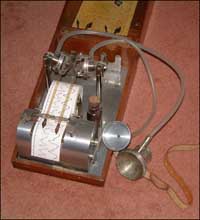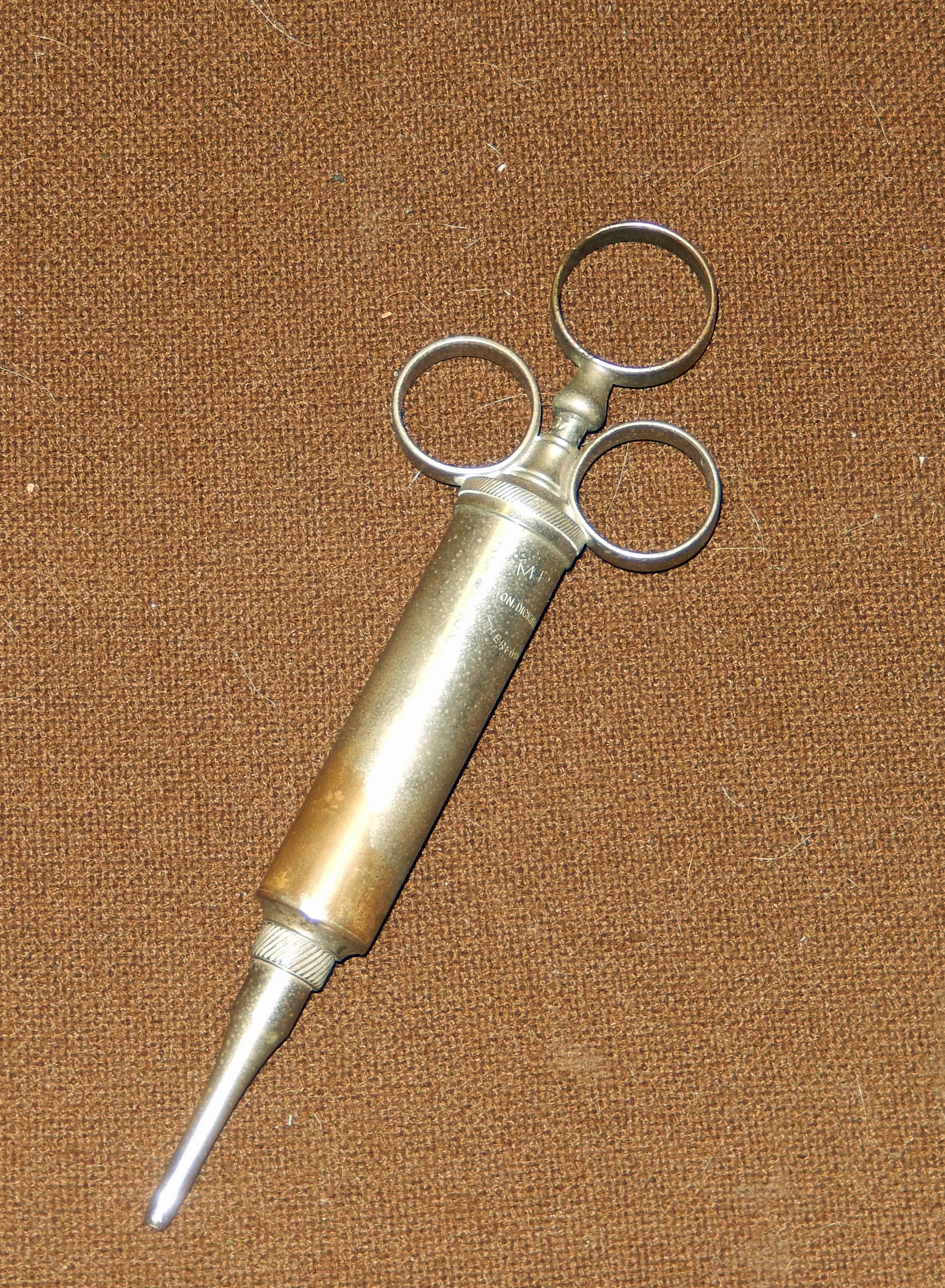It is little known that René Laënnec, the Parisian physician who invented the stethoscope at the Necker Hospital in 1816, found it distasteful to place his ear to the patient’s chest. The distastefulness of “direct auscultation” was compounded by its impracticality in the hospital where, he observed, “it was scarcely to be suggested for most women patients, in some of whom the size of the breasts also posed a physical obstacle.”[1] The stethoscope, which permitted “mediate auscultation,” not only amplified heart and lung sounds in diagnostically transformative ways; it enabled Laënnec to avoid repugnant ear to chest contact.
Many women patients of Laënnec’s time and place did not see it that way. Accustomed to the warmly human pressure of ear on chest, they were uncomfortable when an elongated wooden cylinder was interposed between the two. By the closing decades of the nineteenth century, of course, the situation was inverted: The stethoscope, in its modern binaural guise, had become so integral to physical examination that patients hardly viewed it as a tool at all. It had become emblematic of hands-on doctoring and, as such, a sensory extender of the doctor. Even now, the stethoscope virtually stands in for the doctor, especially the generalist or the cardiologist, so that a retiring physician will announce that he is, or will be characterized by others as, hanging up his stethoscope.[2]
It’s easy to argue for the “oneness” of the physician and his or her instruments when it’s a matter of simple tools that amplify sensory endowment (stethoscopes), provide a hands-on bodily “reading” (of temperature or blood pressure), or elicit a tendon reflex (e.g., the reflex hammer). And the argument can be extended without much difficulty to the more invasive, high-tech “scopes” used by medical specialists to see what is invisible to the naked eye. Instruments become so wedded to one or another specialty that it is hard to think of our providers without them. What is an ophthalmologist without her ophthalmoscope? An ENT without his nasal speculum? A gynecologist without her vaginal speculum? An internist without his blood pressure meter? Such hand-held devices are diagnostic enablers, and as such they are, or at least ought to be, our friends.
In “Caring Technology” I suggested that even large-scale technology administered by technicians, and therefore outside the physician’s literal grasp, can be linked in meaningful ways to the physician’s person. A caring explanation of the need for this or that study, informed by a relational bond, can humanize even the most forbidding high-tech machinery. To be sure, medical machinery, whatever the discomfort and/or bodily bombardment it entails, is often discomfiting. But it need be alienating only when we come to it in an alienated state, when it is not an instrument of physicianly engagement but a dehumanized object – a piece of technology.
Critical care nurses, whose work is both technology-laden and technology-driven, have had much to say on the relationship of technology to nursing identity and nursing care. This literature includes provocative contributions that look at where nurses stand in a hospital hierarchy that comprises staff physicians, residents, students, administrators, patients, and patients’ families.
For some CCU nurses, the use of technology and the acquisition of technological competence segue into issues of power and autonomy and they, in turn, are linked to issues of gender, medical domination, and “ownership” of the technology.[3] A less feminist sensibility informs interview research that yields unsurprising empirical findings, viz., that comfort with technology and the ability to incorporate it into a caring, “touching” disposition hinge on the technological mastery associated with nursing experience. Student and novice nurses, for example, find the machinery of the CCU anxiety-inducing, even overwhelming. They resent the casual manner in which physicians relegate to them complex technological tasks, such as weaning patients from respirators, without appreciating the long list of nursing duties to which such tasks are appended.[4] Withal, beginners approach the use of technology in task-specific ways and have great difficulty “caring with technology.”[5] Theirs is not a caring technology but a technology that causes stress and jeopardizes fragile professional identities.
Experienced CCU nurses, on the other hand, achieve a technological competence that lets them pull the machinery to them; they use it as a window of opportunity for being with their patients.[6] Following Christine Little, we can give the transformation from novice to expert a phenomenological gloss and say that as technological inexperience gives way to technological mastery, technological skills become “ready-to-hand” (Heidegger) and “a natural extension of practice.”[7]
Well and good. We want critical care nurses comfortable with the machinery of critical care – with cardiac and vital signs monitors, respirators, catheters, and infusion pumps – so that implementing technological interventions and monitoring the monitors do not blot out the nurse’s “presence” in the patient’s care. But all this is from the perspective of the nurse and her role in the hospital. What, one wonders, does the patient make of all this technology?
Humanizing technology means identifying with it in ways that are not only responsive to the patient’s fears but also conducive to a shared appreciation of its role in treatment. It is easier for patients to feel humanly touched by technology, that is, if their doctors and nurses appropriate it and represent it as an extender of care. Perhaps some doctors and nurses do so as a matter of course, but one searches the literature in vain for examples of nurse-patient or doctor-patient interactions that humanize technology through dialogue. And such dialogue, however perfunctory in nature, may greatly matter.
Consider the seriously ill patient whose nurse interacts with him without consideration of the technology-saturated environment in which care is given. Now consider the seriously ill patient whose nurse incorporates the machinery into his or her caregiving identity, as in “This monitor [or this line or this pump] is a terrific thing for you and for me. It lets me take better care of you.” Such reassurance, which can be elaborated in any number of patient-centered ways, is not trivial; it may turn an anxious patient around, psychologically speaking. And it is all the more important when, owing to the gravity of the patient’s condition, the nurse must spend more time assessing data and tending to machinery than caring for the patient. Here especially the patient needs to be reminded that the nurse’s responsibility for machinery expands his or her role as the patient’s guardian.[8]
The touch of the physician’s sensory extenders, if literally uncomfortable, may still be comforting. For it is the physician’s own ears that hear us through the stethoscope and whose own eyes gaze on us through the ophthalmoscope, the laryngoscope, the esophagoscope, the colposcope. It is easier to appreciate tools as beneficent extenders of care in the safe confines of one’s own doctor’s office, where instrumental touching is fortified by the relational bond that grows out of continuing care. In the hospital, absent such relational grounding, there is more room for dissonance and hence more need for shared values and empathy. A nurse who lets the cardiac monitor pull her away from patient care will not do well with a frightened patient who needs personal caring. A parturient who welcomes the technology of the labor room will connect better with a labor nurse who values the electronic fetal monitor (and the reassuring visualization it provides the soon-to-be mother) than a nurse who is unhappy with its employment in low-risk births and prefers a return to intermittent auscultation.
In the best of circumstances, tools elicit an intersubjective convergence grounded in an expectation of objectively superior care. It helps to keep the “objective care” part in mind, to remember that technology was not devised to frighten us, encumber us, or cause us pain, but to help doctors and nurses evaluate us, keep us stable and comfortable, and enable treatments that will make us better, or at least leave us better off than our technology-free forebears.
My retinologist reclines the examination chair all the way back and begins prepping my left eye for its second intravitreal injection of Eylea, one of the newest drugs used to treat macular disease. I am grateful for all the technology that has brought me to this point: the retinal camera, the slit lamp, the optical coherence tomography machine. I am especially grateful for the development of fluorescein angiography, which allows my doctor to pinpoint with great precision the lesion in need of treatment. And of course I am grateful to my retinologist, who brings all this technology to bear with a human touch, calmly reassuring me through every step of evaluation and treatment.
I experienced almost immediate improvement after the first such injection a month earlier and am eager to proceed with the treatment. So I am relatively relaxed as he douses my eye with antiseptic and anesthetic washes in preparation for the needle. Then, at the point of injection, he asks me to look up at the face of his assistant, a young woman with a lovely smile. “My pleasure,” I quip, slipping into gendered mode. “I love to look at pretty faces.” I am barely aware of the momentary pressure of the needle that punctures my eyeball and releases this wonderfully effective new drug into the back of my eye. It is not the needle that administers treatment but my trusted and caring physician. “Great technique,” I remark. “I barely felt it.” To which his young assistant, still standing above me, smiles and adds, “I think I had something to do with it.” And indeed she had.
[1] Quoted in J. Duffin, To See with a Better Eye: A Life of R. T. H. Laennec (Princeton: Princeton University Press, 1998), p. 122.
[2] Here are a few recent examples: O. Samuel, “On hanging up my stethoscope,” BMJ, 312:1426, 1996; “Dr. Van Ausdal hangs up his stethoscope,” YSNews.com, September 26, 2013 (http://ysnews.com/news/2013/09/dr-van-ausdal-hangs-up-his-stethoscope); “At 90, Gardena doctor is hanging up his stethoscope,” The Daily Breeze, October, 29, 2013 (http://www.dailybreeze.com/general-news/20131029/at-90-gardena-doctor-is-hanging-up-his-stethoscope); “Well-known doctor hangs up his stethoscope,” Bay Post, February 8, 2014 (http://www.batemansbaypost.com.au/story/1849567/well-known-doctor-hangs-up-his-stethoscope)
[3] See, for example, A. Barnard, “A critical review of the belief that technology is a neutral object and nurses are its master,” J. Advanced Nurs., 26:126-131, 1997; J. Fairman & P. D’Antonio, “Virtual power: gendering the nurse-technology relationship,” Nurs. Inq., 6:178-186, 1999; & B. J. Hoerst & J. Fairman, “Social and professional influences of the technology of electronic fetal monitoring on obstetrical nursing,” Western J. Nurs. Res., 22:475-491, 2000, at pp. 481-82.
[4] C. Crocker & S. Timmons, “The role of technology in critical care nursing,” J. Advanced Nurs., 65:52-61, 2008.
[5] M. McGrath, “The challenges of caring in a technological environment: critical care nurses’ experiences,” J. Clin. Nurs., 17:1096-1104, 2008.
[6] A. Bernardo, “Technology and true presence in nursing,” Holistic Nurs. Prac., 12:40-49, 1998; R. C. Locsin, Technological Competency As Caring in Nursing: A Model For Practice (Indianapolis: Centre Nursing Press, 2005); McGrath, “The challenges of caring,” op. cit.
[7] C. V. Little, “Technological competence as a fundamental structure of learning in critical care nursing: a phenomenological study,” J. Clin. Nurs., 9:391-399, 2000, at pp. 398, 396.
[8] See E. A. McConnell, “The impact of machines on the work of critical care nurses,” Crit. Care Nurs. Q., 12:45-52, 1990, at p. 51; D. Pelletier , et al., “The impact of the technological care environment on the nursing role, Int. J. Tech. Assess. Health Care, 12:35 8-366, 1996.C
Copyright © 2014 by Paul E. Stepansky. All rights reserved.







